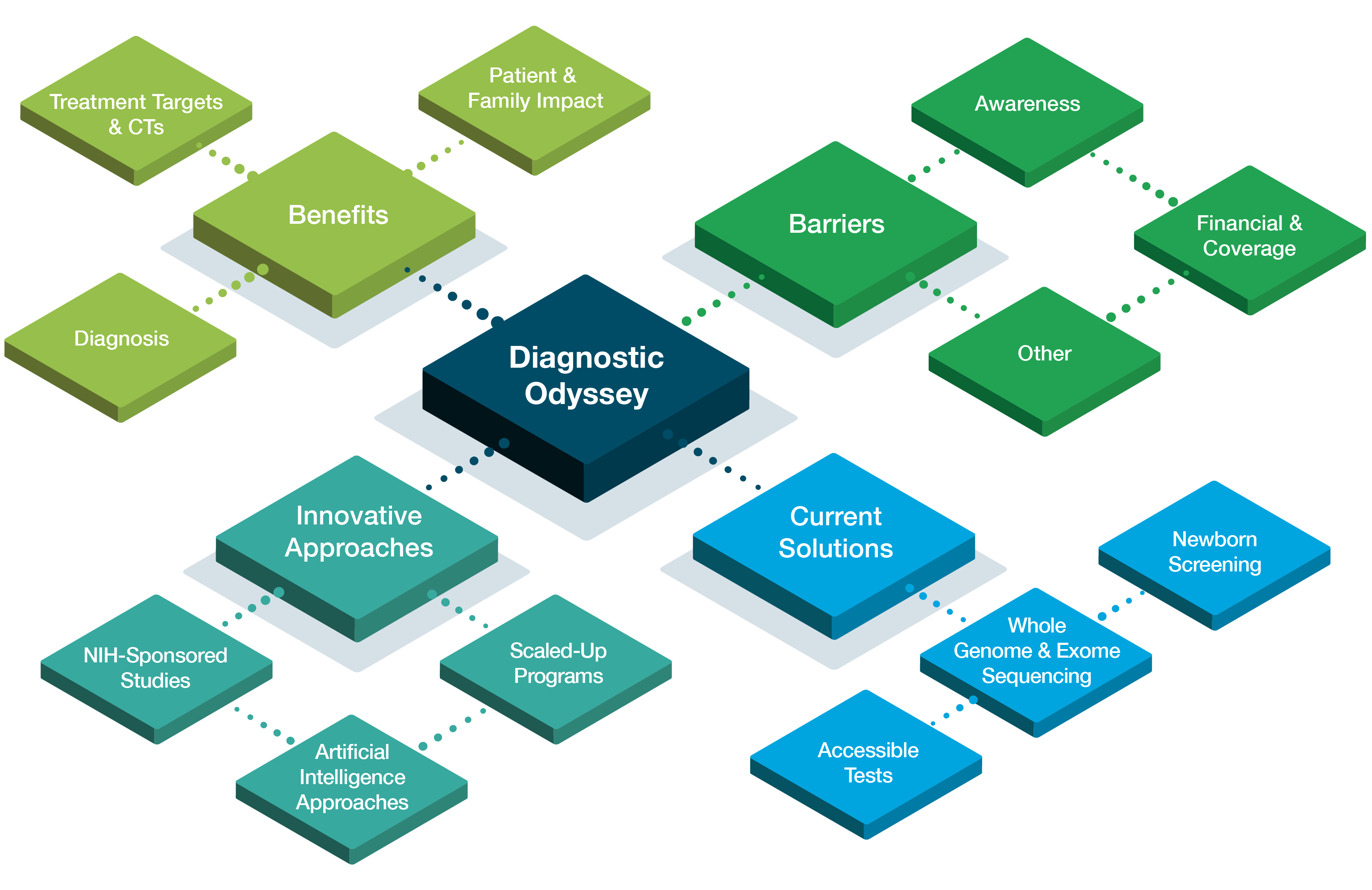Shortening the Diagnostic Odyssey: Benefits, Barriers, and Solutions
Summary
A diagnostic odyssey is defined as the time between when a symptom or feature of a genetic or rare disease is noted to the time when a final diagnosis is made.The average time to receive an accurate diagnosis for patients with rare and ultra-rare diseases is about 4.8 years, and patients may require more than seven specialists to receive a correct diagnosis. During this time, the condition may deteriorate, leading to low quality of life, disability, and, sometimes, premature death. Reducing the time between symptom onset and receiving a diagnosis provides numerous benefits to patients, caregivers, communities, and society.
Certain barriers stand in the way of shortening the diagnostic odyssey, including low disease awareness, access and coverage barriers, specialist shortages, and geographic barriers. Current solutions, such as newborn screening, genetic testing, and genome sequencing, may help in diagnosis and, potentially, treatment of rare diseases. Innovative approaches are also getting started—remaining on a research basis—that may become more widely available to patients.
Below, we outline the benefits to shortening the diagnostic odyssey, barriers that patients face, current solutions, and proposed innovative approaches.

Benefits
Patient & Family Impact
- Accurate diagnosis helps in understanding a disease progression and life expectancy.
- Accurate diagnosis also assists in identification of risks for other health concerns and assist with family planning.
- Identifying a disease provides opportunities to connect with other families and advocacy groups.
Treatment Targets & Clinical Trials (CTs)
- Positive and negative results can inform treatments that target disease etiology, change clinical management, and improve outcomes.
- Identification of the underlying cause may lead to an increase in opportunities to participate in clinical studies based on genetic diagnoses.
Diagnosis
- Accurate diagnosis determines genetic cause or risk factor.
- Accurate diagnoses also provide diagnostic information that eliminates the need for other invasive, unnecessary, or expensive diagnostic tests.
Barriers
Awareness
- Patients and caregivers may not have enough knowledge to request genetic testing.
- Physicians may not be aware of what tests to order for patients.
- Providers may have limited knowledge of alternative access opportunities (e.g., institutional, sponsored testing).
Financial and Coverage
- Some insurance plans may not cover advanced genetic tests or coverage may be limited.
- Patients who do not meet prior authorization criteria may face high out-of-pocket costs.
- National resources for families whose insurance does not cover genetic testing are lacking.
Other
- Providers face large workloads due to a shortage of geneticists, bioinformaticians, and genetic counselors.
- Patients and caregivers may be hesitant to participate in research or lack access to do so.
- Patients may have geographic barriers such as distance to tertiary care, centers of excellence, or genetic testing centers.
Current Solutions
Newborn Screening
- Newborn screening helps identify conditions early and prevents long-term disability or premature death.
- Screenings include a limited list of conditions that vary on a state-by-state basis.
- Adding a condition to the list requires a joint initiative (e.g., patient advocacy groups, manufacturers, providers).
Accessible Tests
- Single gene testing, chromosome microarray, and gene panels are examples of targeted tests that identify structural changes in genes.
- These tests help identify the underlying causal gene mutation(s) leading to a correct diagnosis and potential access to treatments.
- Gene testing detects changes in genes that are not identified by sequencing (e.g., Huntington’s disease, Friedreich’s ataxia).
Whole Genome & Exome Sequencing
- Whole Genome Sequencing (WGS)and Whole Exome Sequencing (WES) help identify genetic variations or provide incidental findings (identify genetic disorder that has not been diagnosed).
- WGS has strict prior authorization requirements and WES is still on a research basis, limiting patient access.
- WGS and WES need both parents to rule out normal variations.
Innovative Approaches
Large-Scale Programs
- Global Commission to End the Diagnostic Odyssey is a multidisciplinary initiative to develop roadmaps and pilot programs aiming to end the diagnostic odyssey.
- US BabySeq Project is designed to measure the utility of providing genomic sequencing to newborns.
- UK Newborn Genome Program aims to sequence and analyze genomes of newborns with the goal of ensuring timely diagnosis and improving health outcomes.
Artificial Intelligence (AI) Approaches
- AI-based facial phenotype analysis enables collaboration between clinicians and researchers to determine the correlation between facial features and rare diseases.
- AI-based motion capture system for diseases that affect movement helps predict a molecular biomarker, improve diagnosis accuracy, and evaluate treatment efficacy.
- Self-supervised image search for histology allows for expedited, accurate, and scalable search of histology images to assist in diagnosis of rare diseases.
National Institutes of Health (NIH)-Sponsored Studies
- Electronic health records (EHR) phenotyping algorithms seek to shorten diagnostic odyssey through EHR identification of children and adults eligible for genetic testing.
- Primary care electronic medical records (EMR)-based machine-assisted referral decision support tool (machine-learning) aims to help identify patients at risk of neurodevelopmental disorders to ensure early specialist referrals.
- Virtual platforms for genetics evaluation of marginalized communities to improve genetic health through timely evaluation and genomic sequencing.
Reducing the length of the diagnostic odyssey for rare and ultra-rare disease patients requires a collaborative approach and may reduce the emotional and economic burden on patients and their caregivers. Various solutions—currently implemented and proposed—may also reduce overall healthcare spending by eliminating unnecessary testing and treatment that patients receive before an accurate diagnosis is made.
Avalere’s subject matter expertise in the rare disease landscape lends in-depth perspectives to support a variety of stakeholders interested in understanding and addressing the diagnostic odyssey. For more information on how Avalere can support your goals, connect with us.
January 23, 11 AM ET
Learn More


